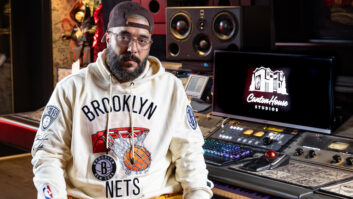New York, NY – July 2008… Sean ‘Diddy’ Combs is, unquestionably, one of rap and hip-hop music’s most prolific talents. In addition to his marquee status as a performer, Diddy is also an accomplished record producer, actor, and all-around entrepreneur. He oversees his Warner Music Group-affiliated Bad Boy Records and also serves as producer of MTV’s Making the Band. Daddy’s House Recording Studio—located in the heart of midtown Manhattan—is the private production facility where a huge percentage of Diddy’s musical efforts take shape. This is a cutting edge studio in every sense of the word, and among its most recent acquisitions is a pair of Q15 studio reference monitors from Equator Audio Research.
Overseeing the day-to-day operations at Daddy’s House Recording Studio is Managing Director and Head Engineer Stephen Dent. Daddy’s House Recording Studio has two main recording studios—each with a control room and an adjacent live room—and there are also two smaller production suites. Dent pointed out, “We purchased our Equator Q15’s about four months ago and in that short period of time; they have had a major impact on our operations. They’ve become so essential to our production that we use them constantly.�
Supplementing a number of Diddy’s own projects that Dent was unable to elaborate on, the Equator Q15’s have also been key to new recording projects for both Danity Kane, a female R&B / Pop quintet and Day26, a male R&B / Pop quintet that were formed during the third and fourth installments respectively of MTV’s Making the Band. Both acts are signed to Bad Boy Records.
In addition to their superior sound quality, Dent has been particularly enamored with the fact that the Equator Q15’s perform consistently at a wide variety of sound pressure levels. “These are terrific sounding nearfield mains that work well at both high and low levels,� said Dent. “Prior to our Q15’s, we were using three sets of monitors—small, medium, and our large mains—depending on what we were listening for and how much volume we needed. The Q15’s have the muscle to provide the levels we want without always having to switch to the mains. Rarely does a client ask to hear something on the big speakers now that we have our Q15’s. This is huge, as I no longer have to switch between multiple sets of monitors in order to ensure that a mix plays consistently from one type of loudspeaker to another. The Q15’s enable us to hear what we need to hear at a variety of levels and this helps us work faster.�
With their newfound popularity, the Q15 monitors are routinely moving from one room to another. With many studio monitors, this situation would present a number of challenges—the most obvious one being the ability to have the room properly tuned to compensate for the sonic anomalies that occur within any listening space.
All Equator Audio Q Series monitors benefit from cutting-edge DSP technology that helps mix engineers ensure their room is optimized for accurate monitoring. The Equator Control software application enables a mix engineer to manually compensate for acoustic anomalies. This software also provides extraordinary control over the monitors—including equalization, mute, solo, and phase. The Equator Automated Room Analyzer software addresses issues created by speaker placement, boundary conditions, standing waves, and secondary reflections by examining a chosen position with a calibrated microphone. It then automatically feeds each speaker’s internal CPU the acquired data which then, in turn, compensates the digitally controlled transducers—adjusting for any and all sonic anomalies that might exist at that position. For Dent, the Q15’s and their DSP capabilities have proven invaluable.
“The room optimization software is definitely one of the best features of these monitors,� says Dent. “Unlike the control rooms, which have been carefully designed for acoustic accuracy, we also use the Q15’s in the production rooms, which unlike the tuned control rooms, are basically four walls with very little acoustic treatment. Occasionally, we even take them to our live rooms that are set up mainly for recording. In both the production and live rooms, we can use the software to tune the rooms and make them able to function as a critical listening spot. Equator’s software enables us to use the monitors anywhere. They provide us with the confidence that any listening decisions we make in these secondary locations will sound correct elsewhere. Best of all, I can run the software and tune the room in a matter of 5-10 minutes.�
Before turning his attention back to the day’s production schedule, Dent offered this closing thought. “The Q15’s sound great no matter where we use them,� notes Dent, “and their ability to handle the mix at different levels is a big plus, since we no longer find ourselves constantly switching back and forth between two or three different sets of monitors. When I want the music loud with lots of bass, the Q15’s deliver. When I need to blend elements of the mix at a lower level, the Q15’s are spot on. That versatility doesn’t exist elsewhere. My only issue with these monitors is that I don’t have my own pair at home!�
For additional information about Bad Boy Records, visit the company online at www.badboyonline.com.
About Equator Audio Research
Equator Audio Research is committed to delivering studio reference monitor solutions that overcome the myriad of challenges faced in today’s audio production. Whether the challenge is on the production line or in the studio control room, Equator is dedicated to identifying and addressing it. Our products are used daily in mission-critical applications at many of the world’s finest recording studios. For additional information on the Q15 and all Equator Audio products, visit the company online at www.equatoraudio.com.
###







